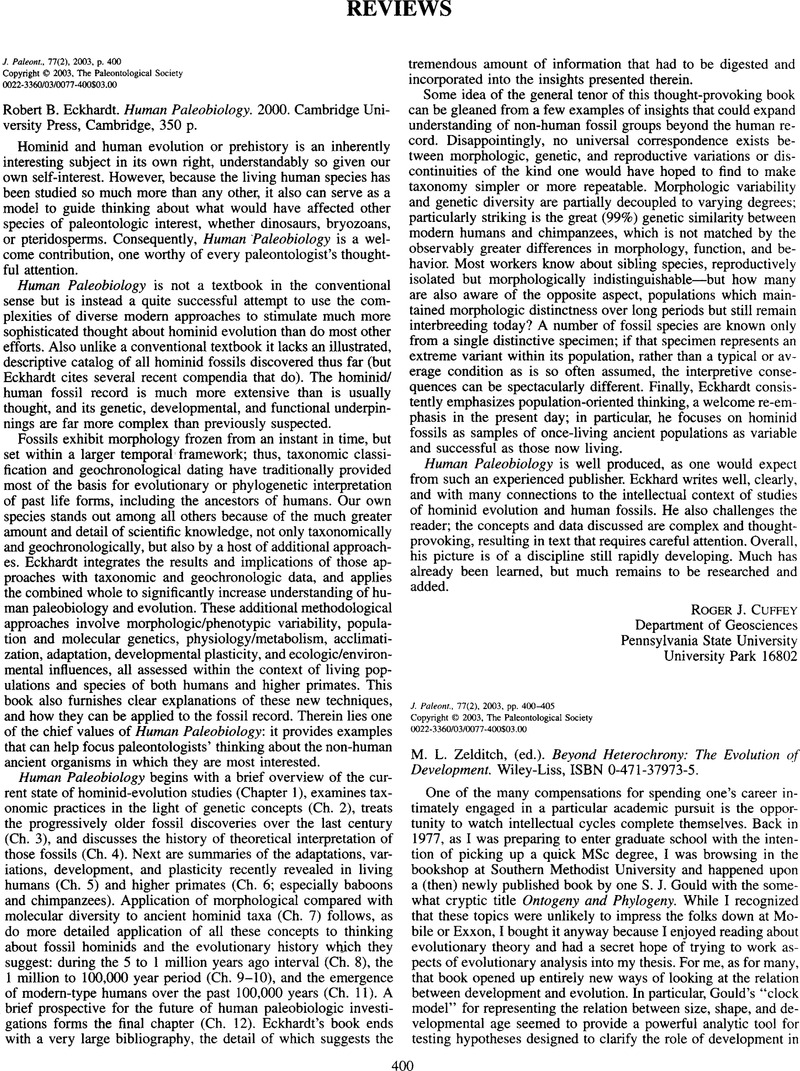No CrossRef data available.
Article contents
M. L. Zelditch, (ed.). Beyond Heterochrony: The Evolution of Development. Wiley-Liss, ISBN 0-471-37973-5.
Published online by Cambridge University Press: 20 May 2016
Abstract
An abstract is not available for this content so a preview has been provided. Please use the Get access link above for information on how to access this content.

- Type
- Reviews
- Information
- Copyright
- Copyright © The Paleontological Society
References
Alberch, P.
1985. Problems with the interpretation of developmental sequences. Systematic Zoology, 34:46–58.CrossRefGoogle Scholar
Alberch, P., Gould, S. J., Oster, G. F., Wake, D. B.
1979. Size and shape in ontogeny and phylogeny. Paleobiology, 5:296–317.CrossRefGoogle Scholar
Bookstein, F., Chernoff, B., Elder, R., Humphries, J., Smith, G., Strauss, R.
1985. Morphometrics in Evolutionary Biology. The Academy of Natural Sciences of Philadelphia, Philadelphia.Google Scholar
Fink, W. L.
1982. The conceptual relationship between ontogeny and phylogeny. Paleobiology, 8:254–264.CrossRefGoogle Scholar
Fink, W. L.
1988. Phylogenetic analysis and the detection of ontogenetic patterns, p. 71–92. In
McKinney, M. L. (ed.), Heterochrony in Evolution: A Multidisciplinary Approach. Plenum Press, New York.CrossRefGoogle Scholar
Gould, S. J., Lewontin, R. C.
1979. The spandrels of San Marco and the Panglossian paradigm: a critique of the adaptationist programme. Proceedings of the Royal Society of London, Series B, 205:581–598.Google Scholar
Harvey, P. H., Brown, A. J. Leigh, Smith, J. M., Nee, S.
1996. New Uses for New Phylogenies. Oxford University Press, Oxford.Google Scholar
Harvey, P. H., Pagel, M. D.
1991. The Comparative Method in Evolutionary Biology. Oxford University Press, Oxford.Google Scholar
McNamara, K. J.
1997. Shapes of Time: The Evolution of Growth and Development. The Johns Hopkins University Press, Baltimore, Maryland.Google Scholar
McKinney, M. L.
1988. Heterochrony in Evolution: A Multidisciplinary Approach. Plenum Press, New York.CrossRefGoogle Scholar
McKinney, M. L., McNammara, K. J.
1991. Heterochrony: The Evolution of Ontogeny. Plenum Press, New York.CrossRefGoogle Scholar
Olson, E., Miller, R.
1958. Morphological Integration. University of Chicago Press, Chicago.Google Scholar
Nehm, R. H.
1998. Macroevolution and development in marginellid gastropods from the Neogene of the Caribbean Basin. Unpublished Ph.D. dissertation, University of California-Berkeley.Google Scholar
Raff, R. A.
1996. The Shape of Life: Genes, Development, and the Evolution of Animal Form. The University of Chicago Press, Chicago.CrossRefGoogle Scholar
Raff, R. A., Wray, G. A.
1998. Heterochrony: developmental mechanisms and evolutionary results. Journal of Evolutionary Biology, 2:409–434.CrossRefGoogle Scholar
Strauss, R. E., Bookstein, F. L.
1982. The truss: body form reconstruction in morphometrics. Systematic Zoology, 31:113–135.CrossRefGoogle Scholar
Zelditch, M. L., Fink, W. L.
1996. Heterochrony and heterotopy: stability and innovation in the evolution of gform. Paleobiology, 22:241–254.CrossRefGoogle Scholar


